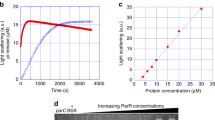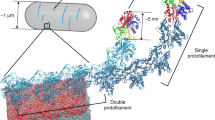Abstract
Bacterial ParM is a homolog of eukaryotic actin and is involved in moving plasmids so that they segregate properly during cell division. Using cryo-EM and three-dimensional reconstruction, we show that ParM filaments have a different structure from F-actin, with very different subunit-subunit interfaces. These interfaces result in the helical handedness of the ParM filament being opposite to that of F-actin. Like F-actin, ParM filaments have a variable twist, and we show that this involves domain-domain rotations within the ParM subunit. The present results yield new insights into polymorphisms within F-actin, as well as the evolution of polymer families.
This is a preview of subscription content, access via your institution
Access options
Subscribe to this journal
Receive 12 print issues and online access
$189.00 per year
only $15.75 per issue
Buy this article
- Purchase on Springer Link
- Instant access to full article PDF
Prices may be subject to local taxes which are calculated during checkout





Similar content being viewed by others
References
Jensen, R.B. & Gerdes, K. Mechanism of DNA segregation in prokaryotes: ParM partitioning protein of plasmid R1 co-localizes with its replicon during the cell cycle. EMBO J. 18, 4076–4084 (1999).
van den Ent, F., Moller-Jensen, J., Amos, L.A., Gerdes, K. & Lowe, J. F-actin-like filaments formed by plasmid segregation protein ParM. EMBO J. 21, 6935–6943 (2002).
van den Ent, F., Amos, L.A. & Löwe, J. Prokaryotic origin of the actin cytoskeleton. Nature 413, 39–44 (2001).
Lowe, J. & Amos, L.A. Crystal structure of the bacterial cell-division protein FtsZ. Nature 391, 203–206 (1998).
Egelman, E.H. A robust algorithm for the reconstruction of helical filaments using single-particle methods. Ultramicroscopy 85, 225–234 (2000).
Egelman, E.H., Francis, N. & DeRosier, D.J. F-actin is a helix with a random variable twist. Nature 298, 131–135 (1982).
Schmid, M.F., Sherman, M.B., Matsudaira, P. & Chiu, W. Structure of the acrosomal bundle. Nature 431, 104–107 (2004).
Galkin, V.E., Orlova, A., Lukoyanova, N., Wriggers, W. & Egelman, E.H. Actin depolymerizing factor stabilizes an existing state of F-actin and can change the tilt of F-actin subunits. J. Cell Biol. 153, 75–86 (2001).
Moore, P.B., Huxley, H.E. & DeRosier, D.J. Three-dimensional reconstruction of F-actin, thin filaments, and decorated thin filaments. J. Mol. Biol. 50, 279–295 (1970).
Egelman, E.H. The iterative helical real space reconstruction method: Surmounting the problems posed by real polymers. J. Struct. Biol. 157, 83–94 (2007).
Heuser, J. Preparing biological samples for stereomicroscopy by the quick-freeze, deep-etch, rotary-replication technique. Methods Cell Biol. 22, 97–122 (1981).
Belmont, L.D., Orlova, A., Drubin, D.G. & Egelman, E.H. A change in actin conformation associated with filament instability after Pi release. Proc. Natl. Acad. Sci. USA 96, 29–34 (1999).
Holmes, K.C., Popp, D., Gebhard, W. & Kabsch, W. Atomic model of the actin filament. Nature 347, 44–49 (1990).
Orlova, A. et al. Probing the structure of f-actin: cross-links constrain atomic models and modify actin dynamics. J. Mol. Biol. 312, 95–106 (2001).
Shvetsov, A., Musib, R., Phillips, M., Rubenstein, P.A. & Reisler, E. Locking the hydrophobic loop 262–274 to G-actin surface by a disulfide bridge prevents filament formation. Biochemistry 41, 10787–10793 (2002).
Popp, D. et al. Concerning the dynamic instability of actin homolog ParM. Biochem. Biophys. Res. Commun. 353, 109–114 (2007).
Bork, P., Sander, C. & Valencia, A. An ATPase domain common to prokaryotic cell cycle proteins, sugar kinases, actin, and hsp70 heat shock proteins. Proc. Natl. Acad. Sci. USA 89, 7290–7294 (1992).
Chik, J.K., Lindberg, U. & Schutt, C.E. The structure of an open state of β-actin at 2.65 Ångstrom resolution. J. Mol. Biol. 263, 607–623 (1996).
Klenchin, V.A., Khaitlina, S.Y. & Rayment, I. Crystal structure of polymerization-competent actin. J. Mol. Biol. 362, 140–150 (2006).
Simanshu, D.K., Savithri, H.S. & Murthy, M.R. Crystal structures of ADP and AMPPNP-bound propionate kinase (TdcD) from Salmonella typhimurium: comparison with members of acetate and sugar kinase/heat shock cognate 70/actin superfamily. J. Mol. Biol. 352, 876–892 (2005).
Nishimasu, H., Fushinobu, S., Shoun, H. & Wakagi, T. Crystal structures of an ATP-dependent hexokinase with broad substrate specificity from the hyperthermophilic archaeon Sulfolobus tokodaii. J. Biol. Chem. 282, 9923–9931 (2007).
Aleshin, A.E. et al. Crystal structures of mutant monomeric hexokinase I reveal multiple ADP binding sites and conformational changes relevant to allosteric regulation. J. Mol. Biol. 296, 1001–1015 (2000).
Aleshin, A.E., Zeng, C., Bartunik, H.D., Fromm, H.J. & Honzatko, R.B. Regulation of hexokinase I: crystal structure of recombinant human brain hexokinase complexed with glucose and phosphate. J. Mol. Biol. 282, 345–357 (1998).
Nolen, B.J. & Pollard, T.D. Insights into the influence of nucleotides on actin family proteins from seven structures of Arp2/3 complex. Mol. Cell 26, 449–457 (2007).
Galkin, V.E., VanLoock, M.S., Orlova, A. & Egelman, E.H. A new internal mode in F-actin helps explain the remarkable evolutionary conservation of actin's sequence and structure. Curr. Biol. 12, 570–575 (2002).
Garner, E.C., Campbell, C.S. & Mullins, R.D. Dynamic instability in a DNA-segregating prokaryotic actin homolog. Science 306, 1021–1025 (2004).
Orlova, A. & Egelman, E.H. F-actin retains a memory of angular order. Biophys. J. 78, 2180–2185 (2000).
Buss, K.A. et al. Urkinase: structure of acetate kinase, a member of the ASKHA superfamily of phosphotransferases. J. Bacteriol. 183, 680–686 (2001).
Aleshin, A.E. et al. Nonaggregating mutant of recombinant human hexokinase I exhibits wild-type kinetics and rod-like conformations in solution. Biochemistry 38, 8359–8366 (1999).
Hara, F. et al. An actin homolog of the archaeon Thermoplasma acidophilum that retains the ancient characteristics of eukaryotic actin. J. Bacteriol. 189, 2039–2045 (2007).
Doolittle, R.F. The origins and evolution of eukaryotic proteins. Phil. Trans. R. Soc. Lond. B 349, 235–240 (1995).
Frank, J. et al. SPIDER and WEB: processing and visualization of images in 3D electron microscopy and related fields. J. Struct. Biol. 116, 190–199 (1996).
Ludtke, S.J., Baldwin, P.R. & Chiu, W. EMAN: semiautomated software for high-resolution single-particle reconstructions. J. Struct. Biol. 128, 82–97 (1999).
Pettersen, E.F. et al. UCSF Chimera–a visualization system for exploratory research and analysis. J. Comput. Chem. 25, 1605–1612 (2004).
Joel, P.B., Fagnant, P.M. & Trybus, K.M. Expression of a nonpolymerizable actin mutant in Sf9 cells. Biochemistry 43, 11554–11559 (2004).
Acknowledgements
This work was supported by US National Institutes of Health grants GM081303 (to E.H.E.) and GM061010 and GM675287 (to R.D.M.).
Author information
Authors and Affiliations
Contributions
A.O. prepared samples and did the EM; E.C.G. prepared samples; V.E.G. did image analysis; J.H. did the quick-freeze/deep-etch EM; R.D.M. did the nucleotide-exchange experiments; E.H.E. did image analysis.
Corresponding author
Supplementary information
Supplementary Video 1
Variable twist in ParM filaments. An animated GIF showing the averaged power spectra computed from the segments in five different bins of the histogram in Fig. 2a. This shows clearly that the sorting is effective, as the power spectra behave exactly as one would expect from segments having different twists. The layer lines shift positions (with respect to the distance from the equator) as the twist varies in these segments. (GIF 572 kb)
Supplementary Video 2
Domains rotate as twist changes. An animated GIF showing a comparison between two twist states of ParM filaments (165.2° and 169.6°) reconstructed from frozen-hydrated specimens (n ∼ 6,000 segments for each). The change in twist (∼ 4°) can be seen to be coupled with a larger change (∼ 10°) in the domain-domain orientation of the two major domains within the ParM subunit. (GIF 1270 kb)
Rights and permissions
About this article
Cite this article
Orlova, A., Garner, E., Galkin, V. et al. The structure of bacterial ParM filaments. Nat Struct Mol Biol 14, 921–926 (2007). https://doi.org/10.1038/nsmb1300
Received:
Accepted:
Published:
Issue Date:
DOI: https://doi.org/10.1038/nsmb1300
This article is cited by
-
Structures of actin-like ParM filaments show architecture of plasmid-segregating spindles
Nature (2015)
-
The ParMRC system: molecular mechanisms of plasmid segregation by actin-like filaments
Nature Reviews Microbiology (2010)
-
Molecular structure of the ParM polymer and the mechanism leading to its nucleotide-driven dynamic instability
The EMBO Journal (2008)
-
Bacterial actin: architecture of the ParMRC plasmid DNA partitioning complex
The EMBO Journal (2008)
-
Journal club
Nature (2007)



